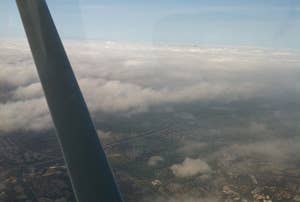
In the Los Angeles basin, there is a phenomenon called the marine layer. Low clouds move in from the ocean and create IFR conditions at the airports close to the shoreline. At Santa Monica Airport, the ATIS may report 700 feet overcast, but that may mean that there is an overcast layer on the ocean-side portion of the runway while the inland side will have CAVU conditions. Time to request a special VFR clearance.
Any private pilot flying below 10,000 feet can request a special VFR clearance from ATC and, if the clearance is granted, need only stay out of the clouds – no minimum distance is required. The ground visibility requirement is also reduced to one statute mile from the general three statute miles for VFR flight in controlled airspace. Essentially, the weather minimums are brought down to Class G airspace requirements below 1,200 feet: one statute mile visibility and clear of clouds.
While the clearance issued by ATC is similar to an instrument clearance and must be read back by the pilot, an instrument rating is not required for special VFR. However, if the request is made between sunset and sunrise, the pilot requesting the clearance needs to be a current instrument pilot. However, special VFR at night is never a good idea since it is impossible to determine where the clouds are. Practice good judgement and request an instrument approach instead.
Special VFR clearances are only issued when cloud ceilings are below 1,000 feet AGL. No matter how familiar you are with the area, flying that low to the ground can be very disorienting and risky. So if the runway is mostly obscured, request an instrument procedure rather than a special VFR clearance or divert to a different airport if you are not IFR rated.
Another word of caution – with a cloud bank at the end of the runway, a go around could be very unsafe. So make sure you are proficient enough and that the wind conditions are such that you can make a full stop on the first try. If you’re not confident that you can achieve this, land somewhere else.
Special VFR can be helpful for proficient pilots who are intimately familiar with the area around the airport, in conditions where the runway is minimally obscured by clouds. In busy airspace such as that around Santa Monica, a special VFR clearance can be a nice shortcut. But, as with many flying-related shortcuts, realize they often come at the expense of increased risk.

Sign-up for newsletters & special offers!
Get the latest FLYING stories & special offers delivered directly to your inbox






